- Bernard Preston homepage
- Starch
- What Is the Quality Test of Carbohydrates
What is the quality test of carbohydrates?
What is the quality test of carbohydrates that are so strongly suspected by the general public of causing weight gain, insulin resistance and CV disease?
The Carbohydrate Quality Index (CQI) is an attempt to evaluate how good or bad a starch is; and whether it should be considered a "cardio-metabolic" risk factor.
Fashions
Fashions in food are just a prevalent as in clothing; and mostly are equally bad. So awful in fact that we have to change them every few years. Currently it's about the quality of carbohydrates but those with long memories will know that we have just graduated from the fats era; and before that whether vegans could be healthy without animal protein.
So the new fashion is that carbs are simply awful; eat less than 20 grams per day. Is that true or is it simply another fad just as absurd as the last one that animals fats are all dreadful?
Ketogenic diets
The latest fashion in foods but really it's not something new, is that we should be eating less than 20 grams of carbohydrate per day; rather we ought to be consuming far more animal protein and fat.
Like all half truths there is some sense in the ketogenic diets. It is carbs after all that have forced the world into probably the worst pandemic ever seen; insulin resistance, obesity and type 2 diabetes. These are the underlying factors in most of the chronic degenerative diseases that have so undermined human health.
But is that all carbs or are some actually healthy? And how can we distinguish between those that are so severely undermining wellness and their first cousins that in reality promote longevity?
What is the quality test of carbohydrate? Is there such a thing that can act as a guideline for us? Yes, there is but it has failed dismally in one respect undermining the whole process, muddying the water and making for even greater suspicion; and confusion.
Carbohydrate Quality Index
The Carbohydrate Quality Index (CQI) is based on four factors.
- The dietary fibre intake (grams per day).
- The Glycemic Index (blood sugar levels 2 hours after consumption of a carb).
- The ratio of whole to total grains.
- The ratio of solid to total carbohydrates.
It is the last one that has muddied the water; more about that later.
Dietary fibre
What is the quality test of carbohydrates? Assessing the fibre content is the first measure; whether they are soluble or not doesn't come into the equation.
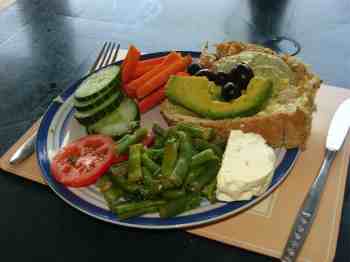 Wholegrain bread, salads and legumes are rich in fibre
Wholegrain bread, salads and legumes are rich in fibreThe recommended dietary allowance varies slightly but generally lies between 30 and 40 grams per day; but only 5% of those eating typical grocery store food are getting sufficient.
Fibre is obtained normally from many foods such as grains, legumes and salads; nuts, fruit and vegetables too obviously.
However few people enjoying the so-called "industrial diet" today come even close to eating sufficient fibre rich food; much has been highly processed to improve the mouth feel.
The research is unequivocal; ultraprocessed foods (UPFs) are strongly associated with cancer and many other diseases.
A 10% increase in proportion of UPFs was associated with 6% higher Colo-Rectal Cancer risk.
Substitution of 10% of the overall proportion of the diet comprising UPFs or PFs with 10% unprocessed foods was associated with a decreased risk of CRC.
- International Journal of Cancer (February 2025)
Let's say you are eating a fairly typical diet of 150 grams of starch per day; late one evening you feel famished for some reason and decide to have a snack of 2 slices of commercial bread with perhaps ham, cheese or just plain butter. You have just increased the ultraprocessed carbs by 25g; the proportion by 14% and your risk of colorectal cancer by around 8 percent.
Instead have an apple and you will lower the risk of CRC.
Glycemic Index
The Glycemic Index of a carbohydrate gives a measure of how it will raise blood sugar two hours after consumption by a healthy individual who is not insulin resistant. High GI starches stress the pancreas' ability to manage serum glucose leading ultimately to hypertension, obesity and dyslipidemia; and eventually diabetes.
In short high GI starches are the chief cause of many of the chronic degenerative diseases such as stroke, heart conditions and diabetes.
- Low GI: less than 55
- Medium GI: 55 to 70
- High GI: greater than 70
Processing of carbohydrates, especially the extraction of fibre but also how they are cooked dramatically effects the Glycemic Index.
Brown rice with the fibre is a borderline low GI carb with a value of 50 to 55 but once polished the Glycemic Index rises above 70 depending on the variety; and can be over 100.
Freshly harvested new potatoes have a large amount of resistant starch giving them a low GI; but once baked, roasted and in particular after being kept in cold storage for months the Glycemic Index can rise to over 100 depending on the variety.
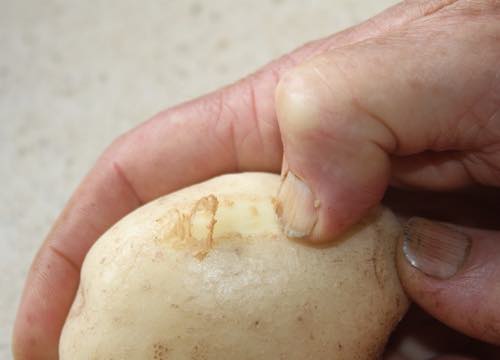 Can you easily scrape the skin off your potato?
Can you easily scrape the skin off your potato?You do not need to peel new potatoes; that's where much of the fibre and important nutrients are found that lower the GI.
And so it goes with legumes and other starches. For example broad beans have a low glycemic index but once skinned, a common practice they become very high GI.
Of interest in all five Blue Zone countries where longevity is the keyword, they grow and consume broad beans; they are the only food that has pharmaceutical amounts of L-dopa, the happy hormone. You are unlikely to find them in the grocery store, either fresh or canned.
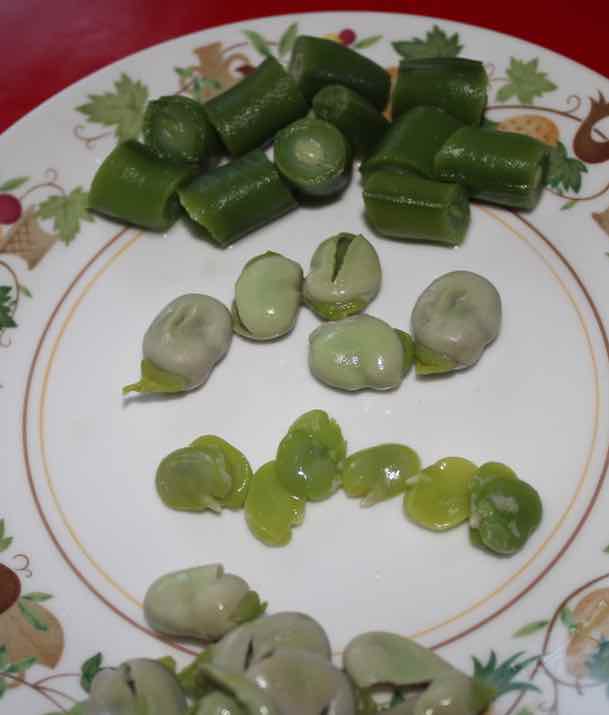 Skinning broad beans ruins them
Skinning broad beans ruins themUltraprocessing of carbohydrates, in particular the extraction of the fibre leads to an increase in GI but also a higher risk of many cancers especially of the colorectal region.
Ratio of whole to total grains
The third test of the quality of carbohydrates is an assessement of the proportion of grains that are considered "whole;" thus corn on the cob would get a very high rating but cake flour extremely low.
The difficulty is there are very few whole grains readily available to most people shopping at grocery stores; brown rice would be another exception but it's expensive and requires longer cooking.
All-purpose, bread and cake flours would be considered ultraprocessed and of a low quality; should they make up a large proportion of the grains consumed, as usually occurs in typical grocery store food, the Carbohydrate Quality Index would be reduced.
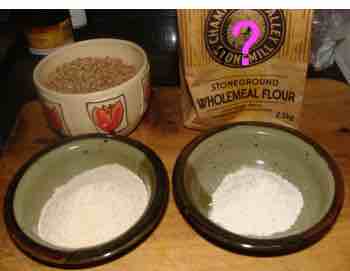 Much of the fibre has been extracted from the flour on the right
Much of the fibre has been extracted from the flour on the rightThere is a strong association between processing of carbohydrates and colorectal cancer risk. Modern grinding extracts most of the fibre from grains which is then sold for animal feed leading to what is being called The Big Fat Lie; millers may by international law label their products as "wholemeal" provided they do not remove more than 40% of the goodies; the germ and bran.
All commercial flours found in grocery stores, even the best of the "wholemeals" consequently are Ultra Processed Foods; the extraction of the fibre gives them a big negative when weighing what is the quality test of carbohydrates.
The flour above on the left is true wholegrain; there is no separation of the three streams of endosperm, germ and bran. It has an "extraction rating" of 100; nothing is removed. It is of a super high quality but is almost unobtainable commercially.
General practice and commercial milling have ensured that true wholemeal is only an option for those with a small home grinder. The flour costs less than a quarter of the best in the grocery store by the way; there's no extra profit in it from the pig farmers for Big Business.
The ratio of solid to total carbohydrates
Up until now everything is as expected. We are not in the slightest surprised that those eating high fibre foods with a low GI and true whole grains have greatly reduced "cardio-metabolic" risks. They are much less likely to be obese; or suffer from heart disease, cancer and type 2 diabetes.
The understanding of solid and liquid starches is where the difficulty has crept in. That has undermined the CQI and our understanding of what is the best quality test for carbohydrates.
"Studies did not find a significant relationship between the Carbohydrate Quality Index and components of Cardio Metabolic Risk Factors[2]."
The reason why the ratio of solid to total carbohydrates has been included is very clear. Commercial liquid colas, fruit juices and energy drinks contain very large amounts of sugars which certainly contribute extensively to cardio-metabolic risk factors.
According to Harvard University research the average American is consuming 17 teaspoons of added sugar per day; about 85 grams. Much of that is in soft drinks. Further to that the natural sweetening in fruit juices and it becomes clear that most people enjoying typical grocery store food are consuming over 100g of liquid carb.
If they are also consuming say 100 grams of solid carbs as in bread and potatoes for example, then the ratio of solid to total carbs could be below 50%; the liquid fraction is far too high. That is a huge negative in the CQI.
So where's the problem?
The assumption being made is that solid carbs are good for us and all those in liquids are bad. If that's not true then the whole CQI is undermined.
Firstly are all solid carbs good for us? An ex president of the American Heart Association is on record as saying that the flour in a chocolate cake is even worse than the sugar; both would get a favourable tick in the CQI but in reality they are serious negatives. Most breakfast cereals likewise are major contributors to raised blood glucose.
Secondly there is at least one liquid carb that is good for us though very few people would be eating it so it's really only of academic interest. That is raw honey that actually lowers the fasting blood glucose of diabetics[3]; but would get a negative tick in the CQI.
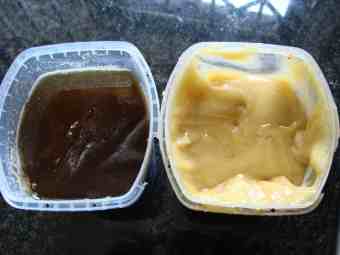 Both are natural honeys; you are unlikely to find them in the grocery store.
Both are natural honeys; you are unlikely to find them in the grocery store.Recommendations
 Straining off the pulp
Straining off the pulpMy initial thought would be simply drop the ratio of solid to total carbohydrates as a criterion from this evaluation of what is the quality test of carbohydrates; it undermines the whole principle of good and bad starches.
Better might be a measure of the total number of grams of both natural and added sugars; with some form of weighting of those from eating an orange compared to a glass of commercial OJ for example. They are of course quite different; one would get a tick and the other a large cross.
But that still leaves us with the problem of healthy liquid foods like natural honey. It's best left to the academics to rework this fourth criterion methinks; until then CQI is a poor predictor of the quality of carbohydrates.
What is the quality test of carbohydrates?
What is the quality test of carbohydrates and why is it important? CQI could have been a useful tool but it's not.
When browsing use right click and "Open Link in New Tab" or you may get a bad gateway signal.
Newsletter
Our newsletter is entitled "create a cyan zone" at your home, preserving both yourself and Mother Earth for future generations; and the family too, of course. We promise not to spam you with daily emails promoting various products. You may get an occasional nudge to buy one of my books.
Here are the back issues.
- Lifestyle and ideal body weight
- What are ultra-processed foods?
- Investing in long-term health
- Diseases from plastic exposure
- Intensive lifestyle management for obesity has limited value
- A world largely devoid of Parkinson's Disease
- The impact of friendly bacteria in the tum on the prevention of cancer
- There's a hole in the bucket
- Everyone is talking about weight loss drugs
- Pull the sweet tooth
- If you suffer from heartburn plant a susu
- Refined maize meal and stunting
- Should agriculture and industry get priority for water and electricity?
- Nature is calling
- Mill your own flour
- Bake your own sourdough bread
- Microplastics from our water
- Alternative types of water storage
- Wear your clothes out
- Comfort foods
- Create a bee-friendly environment
- Go to bed slightly hungry
- Keep bees
- Blue zone folk are religious
- Reduce plastic waste
- Family is important
- What can go in compost?
- Grow broad beans for longevity
- Harvest and store sunshine
- Blue zone exercise
- Harvest and store your rainwater
- Create a cyan zone at your home
Did you find this page interesting? How about forwarding it to a friendly book or food junkie? Better still, a social media tick would help.
- Bernard Preston homepage
- Starch
- What Is the Quality Test of Carbohydrates
Address:
56 Groenekloof Rd,
Hilton, KZN
South Africa
Website:
https://www.bernard-preston.com